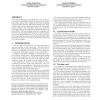Free Online Productivity Tools
i2Speak
i2Symbol
i2OCR
iTex2Img
iWeb2Print
iWeb2Shot
i2Type
iPdf2Split
iPdf2Merge
i2Bopomofo
i2Arabic
i2Style
i2Image
i2PDF
iLatex2Rtf
Sci2ools
122
click to vote
ICCAD
2009
IEEE
2009
IEEE
Multi-level clustering for clock skew optimization
Clock skew scheduling has been effectively used to reduce the clock period of sequential circuits. However, this technique may become impractical if a different skew must be applied for each memory element. This paper presents a new technique for clock skew scheduling constrained by the number of skew domains. The technique is based on a multi-level clustering approach that progressively groups flip-flops with skew affinity. This new technique has been compared with previous work, showing the efficiency in the obtained performance and computational cost. As an example, the skews for an OpenSparc with almost 16K flip-flops and 500K paths have been calculated in less than 5 minutes when using only 2 to 5 skew domains.
Clock | Hardware | ICCAD 2009 | Skew Affinity | Skew Scheduling |
| Added | 18 Feb 2011 |
| Updated | 18 Feb 2011 |
| Type | Journal |
| Year | 2009 |
| Where | ICCAD |
| Authors | Jonas Casanova, Jordi Cortadella |
Comments (0)

